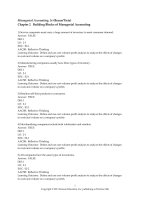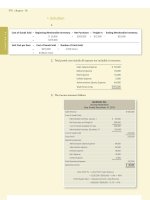Financial managerial accounting 3rd kieso ch19(cost volume profit analysis additional issues)
Bạn đang xem bản rút gọn của tài liệu. Xem và tải ngay bản đầy đủ của tài liệu tại đây (1.02 MB, 69 trang )
Financial & Managerial Accounting
rd
3 Edition
Weygandt Kimmel Kieso
Chapter 19
Cost-Volume-Profit
Analysis: Additional Issues
Chapter Outline
Learning Objectives
LO 1
Apply basic CVP concepts.
LO 2
Explain the term sales mix and its effects on break-even sales.
LO 3
Determine sales mix when a company has limited resources.
LO 4
Indicate how operating leverage affects profitability.
Copyright ©2018 John Wiley & Son, Inc.
2
Basic CVP Concepts
CVP analysis:
Study of the effects of changes in costs and volume on a company’s profit.
Important to profit planning.
Critical in management decisions such as:
LO 1
.
determining product mix,
.
maximizing use of production facilities,
.
setting selling prices.
Copyright ©2018 John Wiley & Son, Inc.
3
Basic CVP Concepts
Basic Concepts
Management often wants the information reported in a special format income statement.
CVP income statement is for internal use only:
LO 1
.
Costs and expenses classified as fixed or variable.
.
Reports contribution margin as a total amount and on a per unit basis.
Copyright ©2018 John Wiley & Son, Inc.
4
Basic CVP Concepts
ILLUSTRATION 19.1
Basic CVP income statement
Basic Concepts
LO 1
Copyright ©2018 John Wiley & Son, Inc.
5
ILLUSTRATION 19.2
Detailed CVP income statement
LO 1
Copyright ©2018 John Wiley & Son, Inc.
6
Break-Even Analysis
Vargo Electronic’s CVP income statement (Ill. 6.2) shows that total contribution margin is
$320,000, and the company’s contribution margin per unit is $200. Contribution margin can
also be expressed as the contribution margin ratio which is 40% ($200 ÷ $500).
Unit Contribution
Margin
Fixed Costs
ữ
$200,000
ữ
$200
Break-Even Point in
=
Units
=
1,000 units
ILLUSTRATION 19.3
Break-even point in units
LO 1
Copyright â2018 John Wiley & Son, Inc.
7
Break-Even Analysis
Vargo Electronic’s CVP income statement (Ill. 6.2) shows that total contribution margin is
$320,000, and the company’s contribution margin per unit is $200. Contribution margin can
also be expressed as the contribution margin ratio which is 40% ($200 ÷ $500).
Unit Contribution
Ratio
Fixed Costs
ữ
$200,000
ữ
.40
Break-Even Point in
=
Dollars
=
$500,000
ILLUSTRATION 19.4
Break-even point in dollars
LO 1
Copyright â2018 John Wiley & Son, Inc.
8
Target Net Income
Once a company achieves break-even sales, a sales goal can be set that will result in a target
net income
Illustration: Assuming Vargo’s target net income is $250,000, compute required sales in units
to achieve target net income :
Unit Contribution
(Fixed Costs + Target Net
Income)
($200,000 + $250,000)
÷
÷
Margin
$200
Sales in Units
=
=
2,250 units
ILLUSTRATION 19.5
Target net income in units
LO 1
Copyright ©2018 John Wiley & Son, Inc.
9
Target Net Income
Once a company achieves break-even sales, a sales goal can be set that will result in a target
net income
Illustration: The contribution margin ratio is used to compute required sales in dollars.
(Fixed Costs + Target Net
Income)
($200,000 + $250,000)
÷
÷
Contribution
Margin Ratio
.40
Sales in Dollars
=
=
$1,125,000
ILLUSTRATION 19.6
Target net income in dollars
LO 1
Copyright ©2018 John Wiley & Son, Inc.
10
Margin of Safety
a.
tells us how far sales can drop before the company will operate at a loss.
b.
can be expressed in dollars or as a ratio.
Illustration: Assume Vargo’s sales are $800,000:
Margin of
Actual (Expected) Sales
$800,000
-
-
Break-Even Sales
$500,000
=
=
Safety in
Dollars
$300,000
ILLUSTRATION 19.7
Margin of safety in dollars
LO 1
Copyright ©2018 John Wiley & Son, Inc.
11
Margin of Safety
a.
tells us how far sales can drop before the company will operate at a loss.
b.
can be expressed in dollars or as a ratio.
Illustration: Vargo’s sales could drop by $300,000, or 37.5%, before the company would
operate at a loss
Margin of Safety in
Dollars
$300,000
ữ
ữ
Actual (Expected)
Sales
$800,000
=
=
Margin of
Safety Ratio
37.5%
ILLUSTRATION 19.8
LO 1
Copyright â2018 John Wiley & Son, Inc.
Margin of safety ratio
12
CVP and Changes in the Business Environment (1 of 5)
Illustration: Original cell phone sales and cost data for Vargo Electronics is as shown.
LO 1
Unit selling price
$500
Unit variable cost
$300
Total fixed costs
$200,000
Break-even sales
$500,000 or 1,000 units
Copyright ©2018 John Wiley & Son, Inc.
13
CVP and Changes in the Business Environment (2 of 5)
Case I: A competitor is offering a 10% discount on the selling price of its camcorders. What
effect will a 10% discount on selling price ($500 x 10% = $50) have on the breakeven point?
Break-Even
Fixed Costs
$200,000
÷
÷
Unit Contribution Margin
$150
($450 - $300)
=
=
Sales
1,333 units
(rounded)
ILLUSTRATION 19.10
Computation of break-even sales in units
LO 1
Copyright ©2018 John Wiley & Son, Inc.
14
CVP and Changes in the Business Environment (3 of 5)
Case II: Management invests in new equipment that will lower the amount of direct labor
required to make cell phones. They estimate that total fixed costs will increase 30% and
variable cost per unit will decrease 30%. What effect will the new equipment have on the
sales volume required to break even?
ILLUSTRATION 19.11
Break-Even
Fixed Costs
$260,000
÷
÷
Unit Contribution Margin
($500 - $210)
=
=
Sales
897 units
(rounded)
LO 1
Copyright ©2018 John Wiley & Son, Inc.
15
CVP and Changes in the Business Environment (4 of 5)
Case III: Vargo’s principal supplier of raw materials has just announced a price increase. The
higher cost is expected to increase the variable cost of cell phones by $25 per unit.
Management plans a cost-cutting program that will save $17,500 in fixed costs per month.
Vargo is currently realizing monthly net income of $80,000 on sales of 1,400 cell phones.
What increase in units sold will be needed to maintain the same level of net income?
LO 1
Copyright ©2018 John Wiley & Son, Inc.
16
CVP and Changes in the Business Environment (5 of 5)
Variable cost per unit increases to $325 ($300 + $25).
Fixed costs are reduced to $182,500 ($200,000 - $17,500).
Contribution margin per unit becomes $175 ($500 - $325).
Unit Contribution
(Fixed Cost + Target Net Income)
($182,500 + $80,000)
÷
÷
Margin
$175
=
=
Sales in Units
1,500
ILLUSTRATION 19.12
Computation of required sales
LO 1
Copyright ©2018 John Wiley & Son, Inc.
17
Basic CVP Concepts
Croc Catchers calculates its contribution margin to be less than zero. Which
statement is true?
LO 1
a.
Its fixed costs are less than the variable cost per unit.
b.
Its profits are greater than its total costs.
c.
The company should sell more units.
d.
Its selling price is less than its variable costs.
Copyright ©2018 John Wiley & Son, Inc.
18
DO IT! 1 CVP Analysis (1 of 3)
Krisanne Company reports the following for June.
Total Per Unit
Sales (5,000 units) $300,000
$60
Variable costs
36
180,000
Contribution margin
Fixed expenses
120,000
$24
100,000
Net income $ 20,000
To increase net income, management is considering reducing the selling price by 10%, with no changes to unit
variable costs or fixed costs. Management is confident that this change will increase unit sales by 25%.
LO 1
Copyright ©2018 John Wiley & Son, Inc.
19
DO IT! 1 CVP Analysis (2 of 3)
Using the contribution margin technique, compute the break-even point in units and dollars and margin of safety in
dollars assuming no changes to sales price or costs.
Solution
a.
Assuming no changes to sales price or costs:
Break-even point in units = 4,167 units (rounded) ($100,000 ÷ $24)
a
Break-even point in sales dollars = $250,000 ($100,000 ÷ .40 )
Margin of safety in dollars = $50,000 ($300,000 − $250,000)
a
LO 1
$24 ÷ $60
Copyright ©2018 John Wiley & Son, Inc.
20
DO IT! 1 CVP Analysis (3 of 3)
Using the contribution margin technique, compute the break-even point in units and dollars and margin of safety in
dollars assuming changes to sales price and volume as described.
b
Break-even point in units = 5,556 units (round) ($100,000 ÷ $18 )
c
Break-even point in sales dollars = $300,000 ($100,000 ÷ ($18 ÷ $54 ))
d
Margin of safety in dollars = $37,500 ($337,500 − $300,000)
b
c
($60 − (.10 × $60) − 36 = $18)
($60 − (.10 × $60)
d
(5,000 + (.25 × 5,000) = 6,250 units, 6,250 units × $54 = $337,500)
LO 1
Copyright ©2018 John Wiley & Son, Inc.
21
Sales Mix and Break-Even Sales
a.
Sales mix is the relative percentage in which a company sells its products.
b.
If a company’s unit sales are 80% printers and 20% computers, its sales mix is 80% to 20%.
c.
Sales mix is important because different products often have very different contribution
margins.
LO 2
Copyright ©2018 John Wiley & Son, Inc.
22
Break-Even Sales in Units (1of 5)
Companies can compute break-even sales for a mix of two or more products by determining
the weighted-average unit contribution margin of all the products.
Illustration: Vargo Electronics sells not only cell phones but high-definition TVs. Vargo sells
its products in the following amounts: 1,500 cell phones and 500 TVs.
Cell Phones
TVs
1,500 units ÷ 2,000 units = 75%
500 units ÷ 2,000 units =
25%
LO 2
Copyright ©2018 John Wiley & Son, Inc.
23
Break-Even Sales in Units (2of 5)
Additional information related to Vargo Electronics.
Cell Phones
TVs
1,500 units ÷ 2,000 units =
500 units ÷ 2,000 units =
75%
25%
Unit Data Cell Phones
TVs
Selling price
$500
$1,000
300
500
Contribution margin
$200
$500
Sales mix—units
75%
25%
Variable costs
Fixed costs = $275,000
LO 2
Copyright ©2018 John Wiley & Son, Inc.
24
Break-Even Sales in Units (3 of 5)
First, determine weighted-average contribution margin.
Unit Data Cell Phones
TVs
Selling price
$500
$1,000
300
500
Contribution margin
$200
$500
Sales mix—units
75%
25%
Variable costs
Fixed costs = $275,000
ILLUSTRATION 6.15
LO 2
Copyright ©2018 John Wiley & Son, Inc.
25









